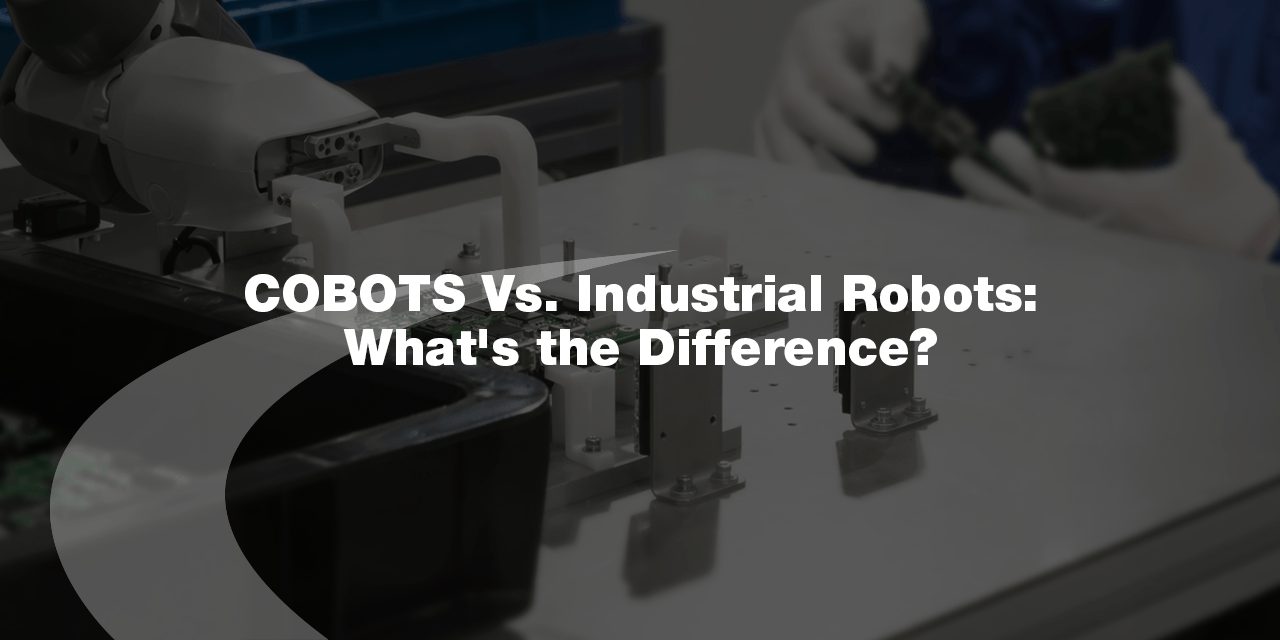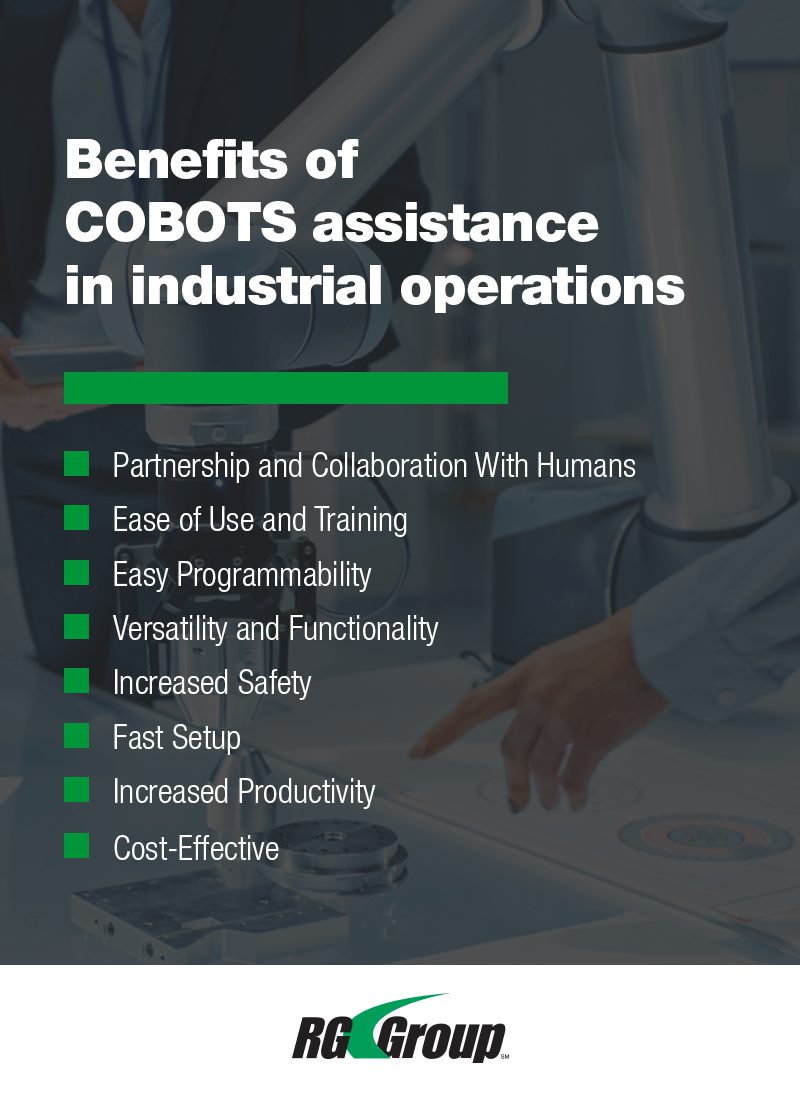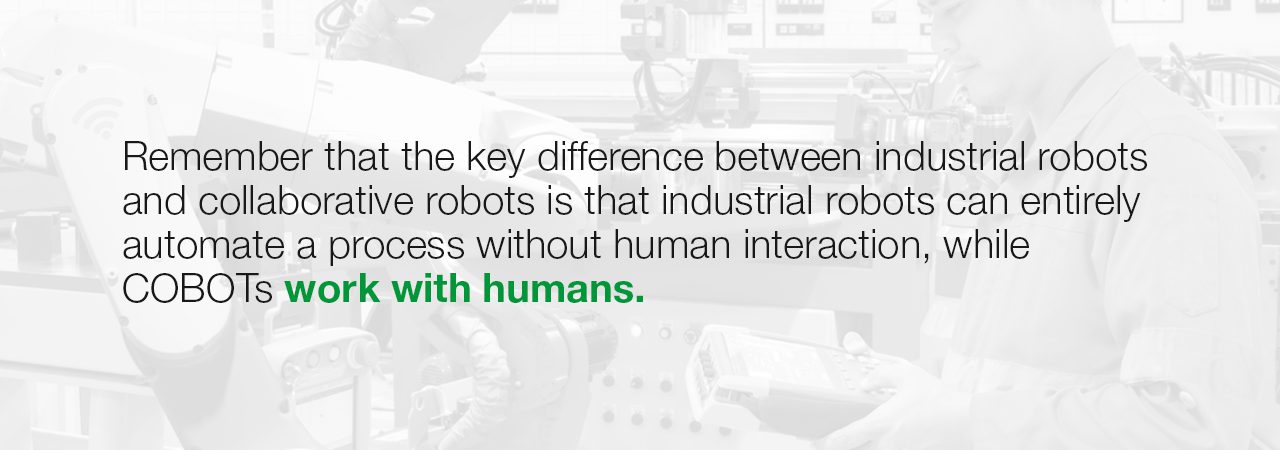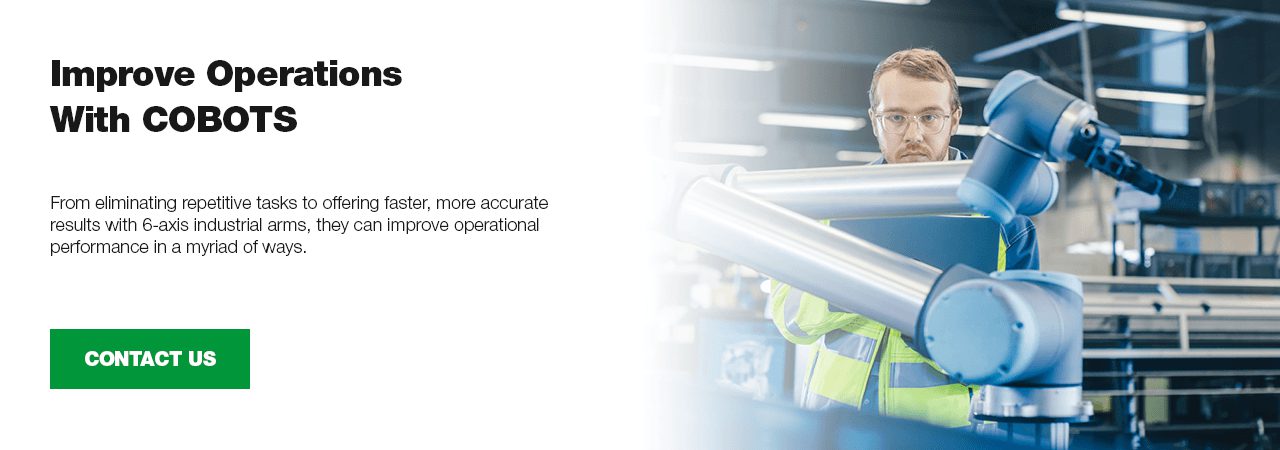
As technology continues to advance, robotics is playing an increasingly important role in industrial operations. There are many different kinds of robotics solutions that today’s businesses use. One important distinction is the difference between robots and COBOTs. How are robots and COBOTs different? While typical industrial robots work on their own and fully take over a given task, COBOTs are collaborative robots. They work with people, not in place of them. COBOTs help to create a hybrid work environment that improves efficiency and safety across a wide variety of industries and tasks.
Some of the ways that cooperative work with robots helps are through:
- Assistance: Traditional robots perform tasks without any human interaction or oversight, but some tasks are too complex for robots alone. That’s where COBOTs differ from industrial robots. COBOTs help human workers and assist them, to speed up tasks or take over monotonous or tedious work, leaving the more complicated stuff to the human workers.
- Seamlessness: COBOTs use a variety of technologies that help them work with humans. With environment-sensing software, mobile programming and safe designs, these COBOTs can be near workers, while helping to improve their efficiency. COBOTS, intended to be in close contact with humans, put safety at the forefront of design.
- Adaptability: The COBOT is typically easy to program and does not require any advanced coding capabilities. It is versatile, adjusting easily to different parts of a workplace and learning about its new environment.
COBOTs offer unique benefits and are useful across industries. They’re rising in popularity and can help businesses improve their efficiency in any number of ways.
Robotics in Manufacturing
From the automatons of ancient Greece to the rise of Numerical Computing and integrated circuits, robotics have come a long way. So has the idea of automation in manufacturing. Henry Ford is an essential figure in the history of automation. Ford cars were one of the first mass-produced items to use an assembly line. This concept restructured how workers would do their jobs for both skilled and unskilled labor. In a Swedish clockmaking shop, Christoffer Polhelm developed a machine to cut cogwheels with the help of hydropower. These men, along with several others in the industrial age, were part of bringing automation into manufacturing, improving the efficiency and changing the landscape of mass-produced items.
In the 1880s, Herman Hollerith developed another piece of technology that proved influential to the world of robotics. He came up with the Electric Tabulating Machine, a punch card system that analyzed holes and “non-holes” within a card. The United States Census even adopted this method by 1890, and it was a significant component to the start of IBM as a company.

As the digital computer came around in the 1950s, things took another turn as information-processing systems could be automated alongside manufacturing. Numerical control also developed around this time, making more advanced programming possible with computer numerical controls (CNC). Shortly after, in the 70s, came the integrated circuit, or microchip, which enabled more advanced electrical circuitry in a small, mass-producible method.
In between these developments came a prototype of an industrial robot, built for a General Motors (GM) factory in 1961. Plenty more were installed in Ford factories in the following years, ramping up the hype about industrial robots. Many of the first robots were hydraulic or pneumatic and capable of handling larger loads than those on the assembly line but were not particularly fast. This situation created a perfect niche for faster electric robots that didn’t need to lift heavy items. They could repeat tasks at high speeds and shorten the cycle time.
These powerful technologies paved the way for modern industrial robots that could perform a wide variety of functions, including:
- Welding
- Painting
- Assembly and disassembly
- Palletizing
- Packaging and labeling
- Materials handling
- Pick and place
Of all these tasks, industrial robots tend to take on tasks that humans can’t do or ones that would improve worker safety or efficiency if performed by a robot. Arc welding, for example, can involve hazards related to heat, fire and explosions, along with possible eye damage from ultraviolet light or the inhalation of dangerous substances. Even simpler tasks, like assembly or disassembly, can have high risks of injury, depending on the job. Lifting heavy objects or using sharp tools can cause harm if an employee makes a mistake.
Assigning these tasks to robots allows people to be safer overall and avoid the most harmful jobs. Plus, many of these tasks require extensive personal protective equipment (PPE) and safety precautions, which creates additional costs and liability concerns for the company. Robots eliminate many of these issues by taking over either the entire job or the more dangerous parts.
Another benefit of delegating to robots is that it frees up employees for other tasks that may be more suited for human work. The robots can take over repetitive, tedious tasks and allow employees to take over more skilled responsibilities. Programming and engineering are some of the jobs that workers can lean toward instead to improve the efficiency of the manual tasks.
What Are COBOTS?
All of those above features apply to traditional robots, but they typically apply to COBOTs as well. These little machines are ideal for marrying the work of humans and technology. They focus on collaboration and teamwork, with features to make workers’ jobs easier and faster without requiring any advanced programming knowledge. Some of the jobs they look to accomplish include those that are repetitive, hazardous or tedious for humans. Safety, versatility and assistance are key features in the design of a COBOT.
The COBOT is smart and learns on the job, understanding the movement of items and speeds as it adjusts to the world around it. And while a COBOT typically has lighter-weight load capacities, it offers exceptional agility and speed, perfect for tasks that require 100% accuracy and faster results.
Below are just some of the benefits that a COBOT can offer.

1. Partnership and Collaboration With Humans
The COBOT works more like a partner than a fully autonomous robot. It can assist with a repetitive task such as picking an item up and placing it somewhere else. It might sit directly beside a person, instead of enclosed behind a safety fence. A COBOT has an intelligence to it, so it can learn about its environment and dynamic surroundings, working in close quarters with human workers.
The collaborative nature of COBOTs makes them easy to work with, while their ease of use reduces the need for advanced programming expertise for small changes, making them a flexible option. Working with people is a foundational aspect of COBOTs.
2. Ease of Use and Training
COBOTs are made to work with all humans — not just those who are programming experts. They are easy to operate for almost any employee, regardless of their technical skill or experience. Employees can even “train” the COBOTs. Often, they do this by merely manipulating the arms and walking it through the process. The COBOT then learns the steps and can replicate them. Many COBOTs even use advanced behavior-learning methods and artificial intelligence to adapt to the task at hand. These traits help make them usable by your everyday employees.
3. Easy Programmability
In addition to training and use, setting up and programming a COBOT is also easy. It doesn’t require advanced programming skills, and employees can reprogram the COBOT for plenty of different tasks.
4. Versatility and Functionality
You can’t pin COBOTs down to just one intended task. They can perform a wide range of jobs and combinations of them, including welding, assembly and pick-and-place. COBOTs move freely, with designs that are lightweight and easy to move. They can stay in one spot and help with repetitive tasks, or you can move them around the facility, with easy reprogramming options and learning capabilities to make the merge to a new environment smooth and productive. Different COBOT models are typically designed to specialize in certain areas of production. In the Doosan line of COBOTs, for instance, we offer models like the M0609, intended for repetitive tasks at high speeds, the M1509 for heavy object handling and the M0617 for multi-tasking and long-range use. Many of these bots are 6-axis articulated collaborative robots with 360-degree joint movements.
5. Increased Safety
One feature that separates the COBOTs from industrial robots is their approach to worker safety. While industrial robots are often autonomous, they also tend to be isolated. They might be blocked off to keep them separated from workers for safety reasons. COBOTs include a variety of design features that make them ideal for use in close contact, such as smooth, rounded edges and advanced sensors. They monitor their surroundings to identify people in the area and can stop wherever they are in the production cycle if someone gets in the way.
In terms of their core functioning, COBOTs also increase safety by reducing the need for human operators to put themselves in dangerous situations. For example, by using a COBOT to apply a coat of paint, human operators can stay away from any hazardous fumes that some paints or coatings produce. A COBOT can also help reduce problems associated with repetitive or stressful movements that create occupational hazards.
6. Fast Setup
The setup process for COBOTs often only takes a few hours. These bots mount onto many different surfaces and can even be moved throughout the facility as needed. With the fast reprogramming processes we discussed, this task allows you to move the COBOT as much or as little as needed.
7. Increased Productivity
The COBOT gets all the typical benefits you’d expect from a robot. It doesn’t get tired or hungry or try to get out of doing work. It focuses on the task at hand and can move more quickly and accurately than humans. Some COBOTs can even learn as they work, suggesting more efficient methods of getting the job done.
8. Cost-Effective
COBOTs are smaller than many industrial robots and can accomplish numerous tasks. With their wide variety of usage options and effects on productivity, COBOTs can offer significant benefits to a company’s bottom line.
Common Misconceptions About Collaborative Robotics

COBOTs offer many benefits, including improved efficiency and safety, but they do have their place. Some people get the wrong idea about what exactly a COBOT can do.
COBOTs are not supposed to replace workers. They are meant to assist and improve existing tasks. Remember that the key difference between industrial robots and collaborative robots is that industrial robots can entirely automate a process without human interaction, while COBOTs work with humans. COBOTs also cannot take on some of the heavy-duty manufacturing jobs that should be performed by an industrial robot. Industrial robots are still necessary for many applications, and COBOTs aren’t merely a lower-cost replacement.
Industries and Processes That Benefit
Due to their versatility and mobility, COBOTs are found in a wide range of industries. They can work with delicate electronics or aerospace parts, help move food items down an assembly line and tend to CNC machines. Nearly every industry, from pharmaceuticals to automotive parts and everything in between, can use COBOTs to improve processes.
Some of the tasks that a COBOT can assist with include:
- Pick and place: This is an extremely repetitive task that is perfect for COBOTs, avoiding injury and mistakes that can happen with human workers. Pick and place involves moving an item from one location to another, typical in packaging and assembly line applications.
- Packaging: Shrink-wrapping, assembling boxes and moving products are all tasks that a COBOT can accomplish.
- Welding: COBOTs can eliminate the repetitive motions and occupational hazards of welding.
- Machine tending: Machine tending involves placing an employee at a machine for long hours to address needs like tool changes or adding materials. COBOTs can free up that operator and tend to multiple machines at once.
- Moving pallets: Some COBOTs, like our line of MiR mobile robots, can even maneuver around a facility and deliver pallets to new locations.
- Quality inspection: Between sensors, cameras and other attached technology, COBOTs can help employees inspect finished products. FANUC robots can be equipped with FANUC’s intelligence features, like iRVision, 3D Vision with FANUC 3D Area Sensor and FANUC Force Sensors.
- Glue application: This is another repetitive task that a COBOT can perform.
- Finishing: Grinding, polishing and other finishing tasks can cause a repeated vibrational force to the worker, forming another occupational hazard. COBOTs can eliminate this risk.
Improve Operations With COBOTs
As you can see, COBOTs are powerhouses for added productivity in the workplace. From eliminating repetitive tasks to offering faster, more accurate results with 6-axis industrial arms, they can improve operational performance in a myriad of ways. Plus, they can make the job safer for employees by taking over dangerous tasks.
If you think your operational procedures could use the help of a COBOT, call RG Group today. Our in-house engineers have the technical expertise to help you find and implement a COBOT in your business. We can help you install your COBOTs and teach you how to use them effectively. When you choose RG Group, you can rest easy with the knowledge that you are partnering with an industry leader with over 60 years of experience. To learn more about COBOTs and industrial robots and how they can work in your business, contact us today.






